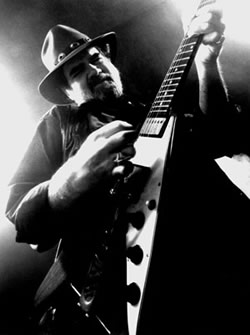This one is not so easy, but it serves as a great exercise in playing barre chords. Good luck!
Lonnie Mack is a lightning-fast, vibrato-wielding, whammy bar-hammered guitar stylist. He has influenced so many people, not to mention Stevie Ray Vaughan, who idolized Mack’s early singles. Vaughan even played with Mack on his 1985 comeback album, “Strike Like Lightning.” Mack’s musical styling is that of Rhythm and Blues, Modern Electric Blues, and Instrumental Rock.
Intro
You should have some fun with this intro. It isn’t difficult, and all based around barre chords, except for the very first measure. Instead of teaching note for note, just understand that when we say move to the sixth fret for example, that would include all fingers that are set in the barre formation. Just adjust that way to make this explanation more understandable and not too lengthy for nothing.
You should have some fun with this intro. It isn’t difficult, and all based on barre chords, except for the very first measure.

Here’s what it sounds like looped at the normal tempo of 120 bpm:
The first measure is an E chord. Place your 1st finger on the first fret on the “G” string. Place your 2nd finger on the second fret on the “A” string. Place your 3rd finger on the second fret on the “D” string. Play that with all other strings open for the first measure.
The second measure is a barre chord on the first fret. Use your 1st finger to barre all of the strings on the first fret. Then, use your 2nd finger to play the “G” string. Use your 3rd and 4th fingers to play the third frets on the “A” string and the “D” string. Play that one whole measure, and move to the second fret with your fingers in position. Play that one whole measure, and then move to the third fret with all fingers still playing like they were from the beginning. For the fourth measure, simply move your fingers to the fourth fret. Play that one whole measure. Now, move your fingers to the fifth fret for the sixth measure. For the seventh measure, move your fingers to the sixth fret. Play that one whole measure, and then move your fingers to the seventh fret for the last measure of the intro. Notice that all you just did was go from fret zero to one, two, three, four, five, six, and seven. Easier than you thought?
Main Theme



This is a bit more difficult. There are twelve measures here. The measures that are identical are as follows:
Measures one, three, seven, and eleven – play these measures by placing your 1st finger on the third fret on the “B” string. Place your 2nd finger on the fourth fret on the “G” string, and your 3rd finger on the fourth fret on the “high E” string.
Play that twice. Let off of the strings and play the open “high E” string and the “G” string, and then barre your 2nd finger to play the second frets on the “high E” string and the “G” string.
Measures two and six – to play these measures, begin by doing exactly what you did at the end of the first measure. Let off the strings as shown, and then use your 2nd finger to barre the desired strings. Measures four, eight, and twelve – these measures are mostly identical to measures two and six, but instead of leaving all strings open at the beginning, use any finger to play the first fret on the “B” string. Your best bet is to use your 2nd finger.
Measure five – use your 2nd finger to play the second fret, and your 3rd finger to play the third fret. Then, all you will need to do for this measure is to use your 1st finger to barre the second frets on the “high E” and “B” string.
Measure nine – use any two fingers or barre any finger here and play it on the fourth fret on the “G” string and the “high E” string. Then, just move to the second fret with the same finger(s).
Measure ten – this measure is actually mostly like the second measure, so just make some adjustments to the number of strings being played and you will be fine.
